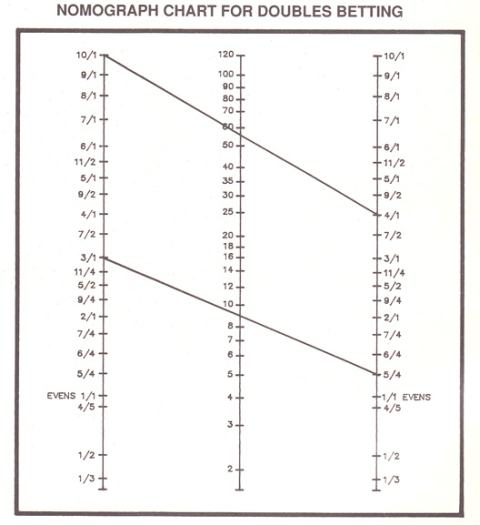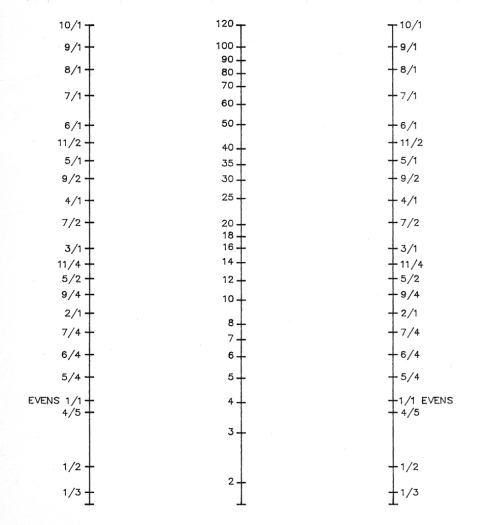In this special article on doubles, Martin Dowling reveals an ingenious betting approach, and unveils a terrific ‘nomograph' chart which instantly indicates how much doubles will pay.
Show me a punter who isn't just a bit fascinated by doubles betting and I'll show you a man who has lost his zest for a quick quid! No, seriously, you have to admit there's a lot of 'fun' in tackling doubles.
We've talked about them many times in P.P.M. and tried to show you, in a string of articles, the various ways you can tackle them, hopefully with a profitable result.
The method I am about to expound may not 'ring a responsive bell' with all of you, but I'm sure a great many readers will be intrigued. If you're the sort of punter who likes to get set early in the day-in other words, place your bets all in one go-this idea could be a beauty for you.
But whichever way you attack your betting, I am convinced you'll enjoy giving this idea a go. It's simple, it demands a stake of $42 (or $21 using 50 cent units) and it provides you with a marvellous opportunity to strike some big doubles. You can use it at the gallops, the trots or the greyhounds.
All you do is pivot your entire day's racing around the first event on the programme. You back the top six horses (or dogs) in the pre-post market With ONE horse in every other race. Get the idea?
If you strike the first race winner-and most times you will- you will be sitting on a potential seven doubles.
Naturally, most days you won't strike all seven (!!) but often enough you will get two, maybe three and even four, doubles rolling up for you, depending on just how good your selections are.
It's a real grand slam approach. The beauty of it is when you strike a decent priced winner in that first race. By backing the top six in the market you are giving yourself a fair chance of raking in winners around the 5-1 to 10-1 mark.
Imagine starting the day with a 10-1 winner and then knowing you have it linked into seven other horses, all in different races, for the day. You'd be trembling with anticipation.
It would be easy, using the special 'Nomograph Chart' which accompanies this article, to work out possible dividends that might come your way. The Doubles chart helps Nomograph is a terrific idea, I'm sure you'll agree.
All you do is find the prices of the horses you have in a double and draw a line between them. Where it crosses will be the dividend you'll get!

Let's say you have a 10-1 chance going into a 4-1 chance. By drawing your line from the 10-1 mark to the 4-1 chance you will see that it crosses at the midway mark between 50 and 60, indicating a doubles return of 55.
Another example: A 3-1 chance linked with a 5-4 chance. The line you draw will cross midway between the eight and 10, indicating a return of nine.
It's easy to realise that having got your first race winner home you could be in for a huge day at the races. You have outlaid a total of $42. A nice winner at, say, 61 coupled with a 4~1 chance in the second race would see you looking at a possible 35 return, leaving you only seven short of a break-even day.
Let's say you struck just one more double, that first 6-1 winner into a 3-1 chance. That would return you 28 units.
On the day, then, you would have copped 35 on the first winning double and 28 on the second-a grand slam total of 63, for a lovely profit of 21 units on the day. A third winning double would have had you rolling in the aisles!
A friend of mine runs a syndicate which operates this method and he swears by it. But he adopts a slightly different approach in that he ignores any horse under 4-1 in the pre-post market, and tries to pick six horses with real value chances.
He then links his six selections with the favourites in all the other races. He tells me he and his syndicate have struck some absolutely marvellous winning days.
An example was at Randwick on January 11, when the syndicate struck a 20-1 winner, Mighty Ascent, in the first race, and then saw four of the favourites win in the other races. The $42 outlay returned them close to $200.
Of course, you don't have to restrict yourself to six dogs. You can take more or fewer. At the greyhounds you could think about backing the field in the first race and then linking all the runners with a selection in each of the other nine races. This is rather expensive. Why not, then, pick five other dogs. This would cost only $40 (or $20 with 50c units) and gives you the chance of a maximum five doubles.
The cast-iron certainty of the first leg of a series of doubles is very attractive. In horseracing, if you have a small field--of six or seven runners-you could quite easily back the whole field.
Another approach to this is to use the last race as the field, or multiple, bet. With this idea, you pick a horse in each of the first seven races and back them with your six horses, or the field in the last race.
Naturally, it is a method that you should not rush into willy-nilly. Instead, take your time and think about your plan of attack. Carefully weigh up the potential returns-use the Nomograph!! -and if there does seem a reasonable chance of a big win then you hop in and go for the Grand Slam.
But you only bet when you are sure in your own mind that you have a viable financial proposition. Go over your multiple-bet race very carefully. Leave no stone unturned.
Sift through the form, check as many sources as you can, and only when you are absolutely certain you have chosen the correct six horses do you move on to the other races for the individual selections.
These are just as important. Just imagine if you are sitting on a 20-1 winner from the first race-you would want all the horses linked with it in the doubles to have sound chances, wouldn't you?
So pick carefully. Don't rush things. Don't go to the TAB office and try to pick them by standing there glancing at the form on the wall! That's not the way to do it. The form study must be done in the comfort of your own home, over a period of hours.
Fools rush in where ... Remember the old saying. Applied carefully, with decent selections, this Grand Slam doubles method can be a real winner for you.
As I say, if s probably not a method that will appeal to everyone. But look at it this way-you go to the races for the day and you want some action. Why not try this idea on a reduced scale. Take, say, eight horses in the first race and link them with one horse in each of another four races.
This will cost you only $32 using $1 units. A winner at 5-1 in the first race coupled with one 9-2 winner in just one of the other legs will square you off on the day. A second winner will put the cream on the cake.
The same thing applies at the dogs. You could back the field in the first race, and then couple the winner with a dog in each of, say, three other races. A total outlay of just $24. One double at 9-2 and 7-2 will square the bet completely.
- Photocopy this chart and use it whenever you want to calculate your likely doubles dividend.
- Mark the left-hand column at the price of your first runner. Do the same on the right-hand column for your second runner, and draw a line between the two marks.
- Where the line crosses the centre column will be the likely dividend.

By Martin Dowling
PRACTICAL PUNTING - APRIL 1989